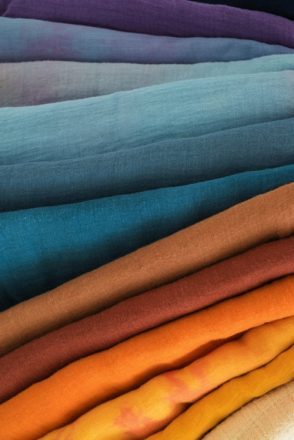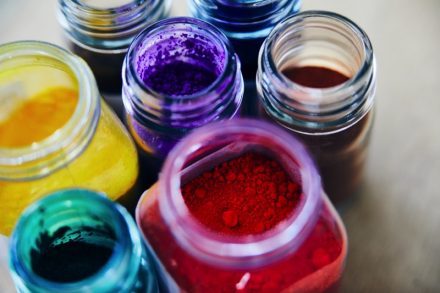Smart Key: How to color garments without leaving a stain on the environment? The - Première Vision New York - Première Vision Paris - Denim Première Vision
What’s next season’s color? This is probably the most frequently asked question when you tell people you work in fashion. Mirroring our moods, outfits can be pretty in pink or moody in black, can feel a little blue, or can even encapsulate a generation with Millennial Pink or Gen Z Yellow. Color is an essential way of demonstrating state of mind and allegiance. But however much we love them, the hues of our outfits also leave a black mark on the environment.

Emissions are far from rosy
During an evaluation of CO2 emissions by Quantis during the entire life cycle of a garment, the dyeing and finishing phases represented 36% of impacts, earning an unenviable first place among the most energy-demanding stages. The many water-based processes, pre-treatments and dyeing cycles require large volumes of heated water, resulting in exorbitant energy consumption.

Not very green chemicals
To this, we can add the impact of the chemicals used.
The pre-treatments used to clean and prepare fibers to absorb dyes can represent a source of risk.
Colorants themselves have a variety of properties. Some are water soluble, such as acidic, direct, mordants or basic colorants, others are insoluble such as pigmentary colorants, dye bath, reactive or dispersed colorants.
Of natural or fossil fuel origin, these components can generate water pollution and health risks. Their presence in the liquid effluent after the dyeing process or as a result of washing the textiles represents a serious risk, if it is not purified, to the quality of the water courses into which it is discharged.
Regulations differ according to the region of the world and even according to the country. Millions of chemical substances have been examined by Reach, and around 100 dyes can still be found on the market in regions outside of Europe and end up in dyeing baths.
Read also: Smart Key: Fashion and chemistry… a dangerous liaison?

Diving in troubled waters
Certain azo dyes, for example, have a fixation rate on fabric of 15 – 50% during the dyeing process, and are still frequently rejected in wastewater without undergoing rigorous treatment.
This water is then used for irrigation of agricultural land, which in turn affects the microbial population in the soil as well as the germination and growth of plants.
This is because, when they are not biodegradable, the presence of these dyes and pigments can lead to a serious alteration in the environment of aquatic plants and animals. This negative impact on the equilibrium of the aquatic environment can cause a high risk of under-oxygenation, reduced photosynthesis or odor. Long-term dangers are also seen, with the persistence and bio-accumulation of components that are toxic, mutagenic and carcinogenic, able to enter the food chain and thus accentuate the dispersion of risks.
So how can I achieve vibrant colors and harmless impacts?
SMART KEY 1 – Explore raw or natural color
Undoubtedly the solution with the lowest impact is to leave the fiber undyed.
An option that has been adopted by the most militant labels, making the original color of the fiber the color dress code.
Working with the greyish beige on linen, the cream to chocolate shades of woolen fleece, naturally pinkish or greenish cottons and the pinkish-beige of basil leather, even with a restricted palette, fashion creativity is possible.

Another possibility is plant-based dyes. They had previously been overlooked as their reproducibility and their homogeneity were unsatisfactory, they showed lower resistance to light, washing and rubbing, and they required risky metallic mordants. Things have since developed, however, as shown by the large range of colors and exemplary quality of Greendyes.
Seaweed-based dyes from Algaeing and tea residues from T-Hues optimize unexpected resources. Meanwhile, the Indidye technology makes it possible to fix plant-based colors using a system of ultra-sound rays, meaning toxic pre-treatments are no long necessary.
SMART KEY 2 – Keep a close eye on chemistry
To ensure a more responsible use of chemicals, Oeko-tex Eco Passport, ZDHC, Cradle to Cradle, GOTS and Blue Sign scrutinize the substances used and ensure they are non-toxic.
On finished products, Oeko-tex Standard 100 or Oekotex Leather Standard attest to a finished product free of risks.

An assessment of the Chemical Oxygen Demand (COD) and Biochemical Oxygen Demand (BOD) of effluent can be used to analyze the pollution or potential biodegradability of waters. The main pollutants, such as the high level of material in suspension, heat, color or acidity have to be treated with a combination of physical, chemical and biological processes to clean up the waters.
SMART KEY 3 – Dye without water
Many procedures enabling minimal consumption of water and energy now exist on an industrial scale.
Used in textile printing, ink-jet technologies have been finetuned and can now dye fabrics. These high-performance techniques spray color at high speed to the very heart of the fiber. The lower demand for water, substantially reduced dyeing times, and very precise process generate a minimum of impact.
The Imotech and Coloreel machines or the Imogo spray techniques are compatible with all types of dyes and offer maximum efficiency.

Another possibility is super-critical CO2. It draws its strength from the use of high pressure, allowing carbon dioxide to move to a fluid state. In this way it can be used to replace water, dissolving pure colorants and dyeing yarns and fabrics with the same effectiveness as a conventional process. Deven Supercriticals can be used to dye cotton and polyesters, Dyecoo has already plenty of fans in denim.
Still on denim, foam technologies use a foaming agent to cover the fabric with foam. The material is passed through two rollers to ensure a homogenous distribution then exposed to a high temperature to bond it and fix it to the fibers. A way of saying goodbye, at last, to successive indigo baths using this optimized process.
SMART KEY 4 – Be surprised by innovation
Disruptive technologies offering a radically different approach, have started to move from pilot projects towards application on a more industrial scale.
Often looked at from the perspective of regenerating fiber, recycling is now offering the possibility of coloring materials.

Textile offcuts or used garments can become a source of color thanks to the Recychrom™ process from Officinia+39 which transforms fabrics into an extra-fine colored powder, acting like a pigmentary dye. Easier to filter and with minimal wastewater treatment required, this dye can be used on all types of textiles.
DyeRecycle explores a solution free from toxic solvents, making it possible to extract the color from synthetics and reuse it as a color bath for other items. An ingenious way of creating a dye on the one hand and returning to white textiles on the other, in order to generate stocks of uniform materials for subsequent recycling.
The most niche method comes from biotechnology. Microbiology and the study of the DNA of natural organisms have allowed Pili, Colorifix and Huue to develop fermentation techniques that can be used to create colorants thanks to the action of microorganisms whose biological code contains enzymatic catalyzers. Like something out of science fiction, and with great potential for removing the need for fossil fuel resources while meeting the exacting requirements of the market, these solutions are developing the dyes of tomorrow.
Investment in new technologies is very expensive, but is the price to pay in order to render the impacts of dyeing whiter than white. The support of labels, in the form of a durable commitment with their suppliers or via joint investments, is the best way for carving out new and richly colored routes for the future.
SOURCES
- Quantis – Measuring Fashion (2018)
- Mohamed Berradi, Rachid Hsissou, Mohammed Khudhair,Mohammed Assouag, Omar Charkaoui, Abderrahim El Bachiri, Ahmd El Harfi – Textile finishing dyes and their impact on aquatic environs (Novembre 2019)
- Bruno Lellis, Cintia Zani Favaro-Polonio, Joao Alencar Pamphile, Julio Cesar Polonio – Effects of textile dyes on health and the environment and bioremediation potential of living organisms (Avril 2019)
- Fashion For Good – Textile processing guide: pre-treatment, coloration and finishing (Janvier 2022)
